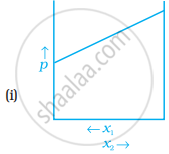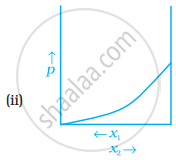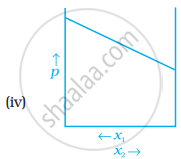Advertisements
Advertisements
Question
Why is the vapour pressure of an aqueous solution of glucose lower than that of water?
Solution
In pure liquid water the entire surface of liquid is occupied by the molecules of water. When a non volatile solute, for example glucose is dissolved in water, the fraction of surface covered by the solvent molecules gets reduced because some positions are occupied by glucose molecules. As a result number of solvent molecules escaping from the surface also gets reduced, consequently the vapour pressure of aqueous solution of glucose is reduced.
APPEARS IN
RELATED QUESTIONS
30 g of urea (M = 60 g mol−1) is dissolved in 846 g of water. Calculate the vapour pressure of water for this solution if vapour pressure of pure water at 298 K is 23·8 mm Hg.
State Raoult's law for the solution containing volatile components. What is the similarity between Raoult's law and Henry's law?
The vapour pressure of benzene at 30°C is 121.8 mm. By adding 15 g of non-volatile solute in 250 g of benzene, its vapour pressure is decreased to 120.2 mm. The molecular weight of solute is:
The vapour pressure of pure benzene at 25°C is 640 mm Hg and that of solution of solute A is 630 mm Hg. The molality of a solution is:
The solubility of a solid in a liquid is significantly affected by temperature changes.
\[\ce{Solute + Solvent -> Solution}\]
The system being in a dynamic equilibrium must follow Le-chatelier’s principle.
Considering the Le-chatelier’s principle which of the following is correct?
At a particular temperature, the vapour pressures of two liquids A and B are respectively 120 and 180 mm of mercury. If 2 moles of A and 3 moles of B are mixed to form an ideal solution, the vapour pressure of the solution at the same temperature will be (in mm of mercury):
A solution containing 10 g per dm3 of urea (molecular mass = 60 g mol–1) is isotonic with a 5% solution of a non-volatile solute. The molecular mass of this non-volatile solute is:
For a binary ideal liquid solution, the variation in total vapour pressure versus composition of solution is given by which of the curves?



The vapour pressure of a 5% aqueous solution of non-volatile organic substance at 373 k is 745 mm. calculated the molecular mass of the solute
The vapour pressures of pure liquids A and B are 400 and 600 mm Hg, respectively at 298 K On mixing the two liquids, the sum of their initial volumes is equal to the volume of the final mixture. The mole fraction of liquids B is 0.5 in the mixture. The vapour pressure of the final solution, the mole fractions of components A and B in vapour phase, respectively are ______.
